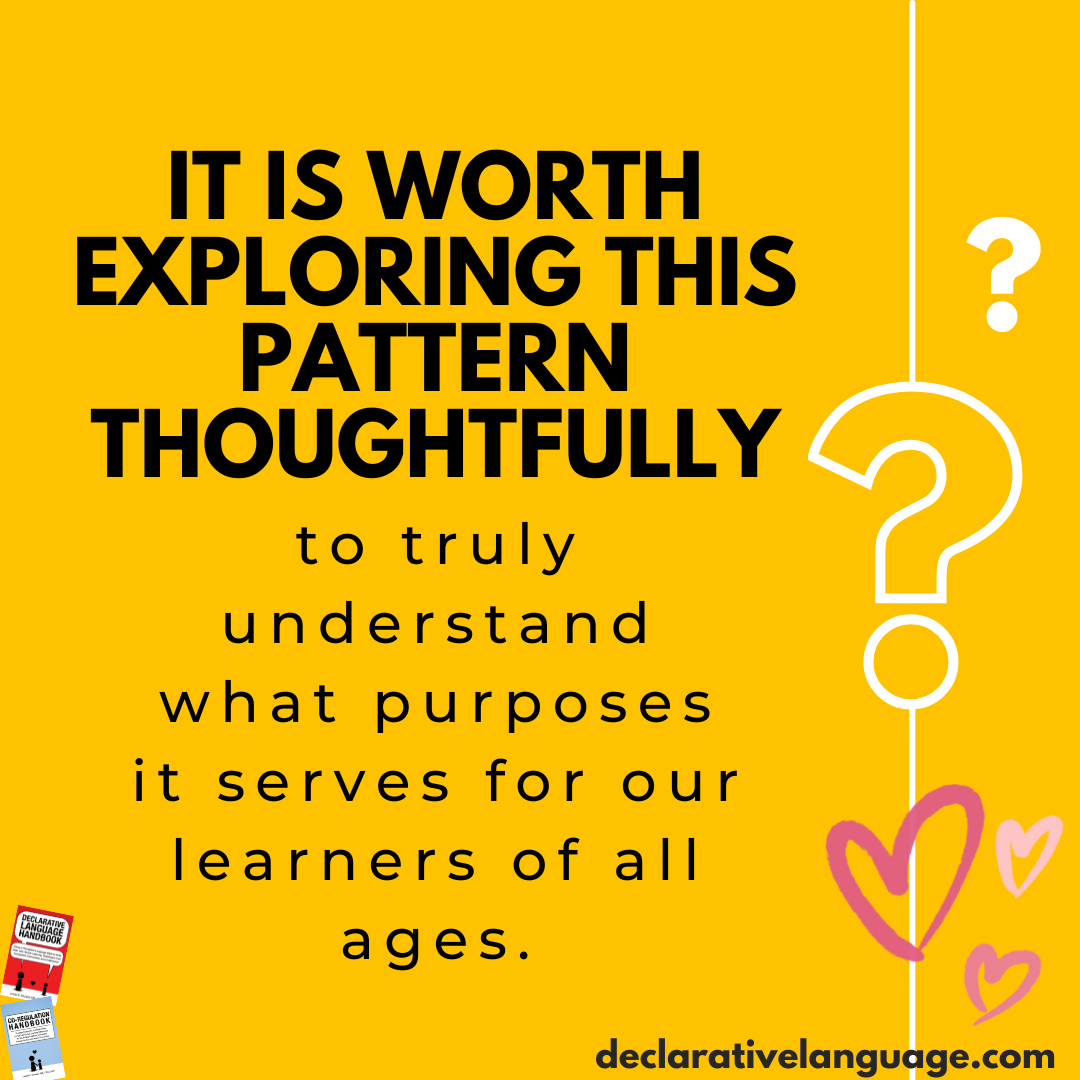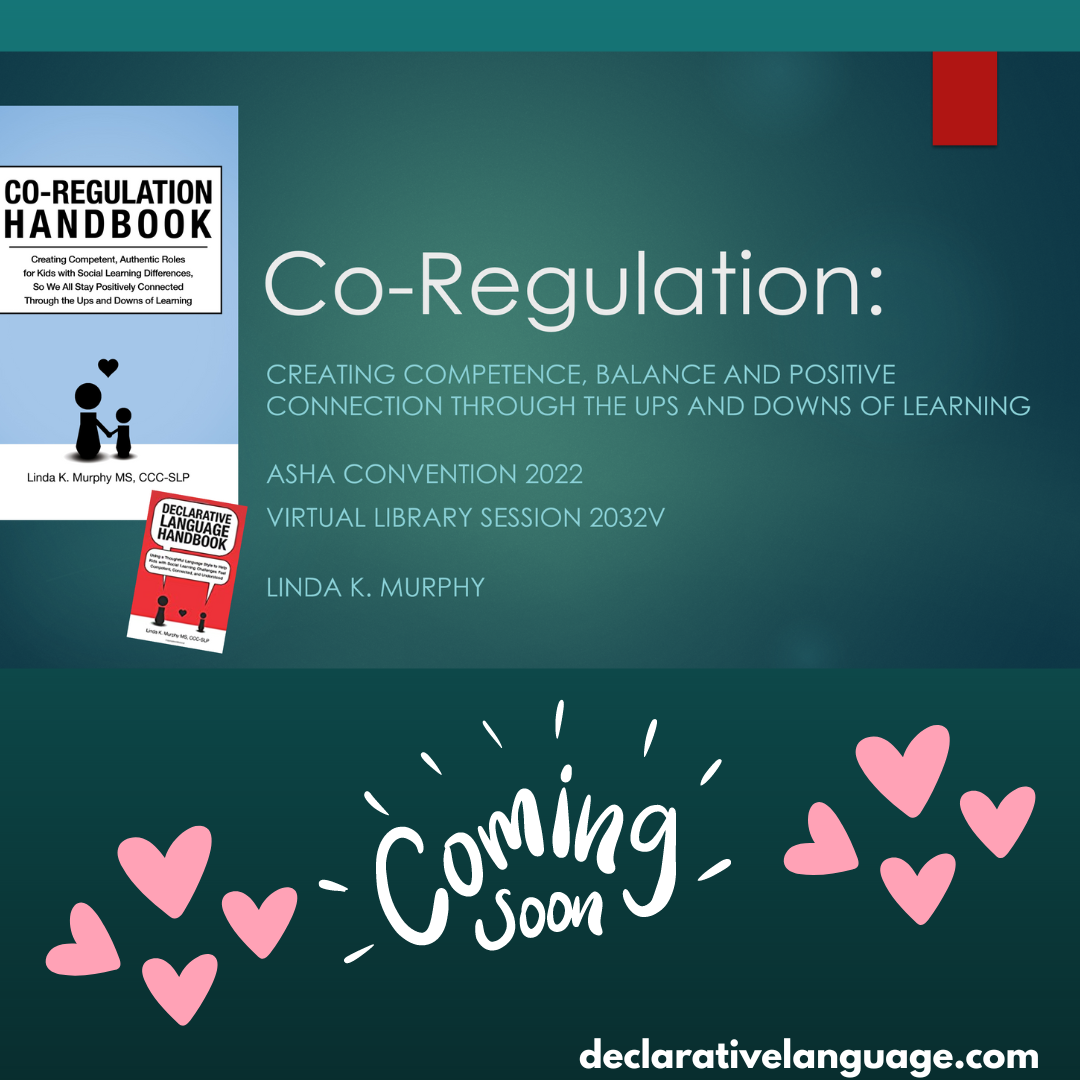When Kids Ask Questions They Know The Answer To
I always receive fantastic questions from families in our Declarative Language Workshop! To follow is a recent one that I imagine is applicable to other people. With this parent’s permission, I am sharing it here, along with my answer and food for thought on the topic!
Dear Linda,
D. asking questions that she knows the answer to makes up almost 70-80% of her daily conversation. It was even more so before we started this workshop. In the last couple of years, we have been trying to remind her that she doesn’t need to ask something she already knows the answer to. Her reaction was the same each time by saying “I don’t need to ask; I knew it already” or “I could have said …….”, which is a statement form of her question. But when she uses this form to talk to people that know her less well, they tend to answer her questions which feels like an encouragement to her. I could not track back how it started. From your knowledge, is this common? Is there a more effective way to deal with it?
My answer…
Yes, I think this is common!
And, I think it is worth exploring the pattern at hand thoughtfully, to truly understand what purposes it serves for our learners of all ages.
The meaning of question-asking is likely highly individual to each person. I am sure it serves different purposes, for different people, at different times. We always want to remember this.
With that caveat, I will share some of my personal observations related to question-asking.
First and foremost, I believe that it is regulating for some individuals to ask questions that they know the answer to. It is calming and reassuring, and as they ask and we answer in the expected way, it helps them feel safe. We are also, as a result, engaging in a co-regulatory pattern, and co-regulation is essential for all learning and connection. This particular pattern is an important starting place for many kids and adults, and not one to try to stop.
Rather, the question, or decision, for us becomes:
When do we hang out together in that predictable pattern because the individual needs it to regulate in the moment
versus
When (and how!) can we expand upon this pattern to support communicative growth, so that relationships grow and deepen!
In regards to #1, I think this co-regulatory pattern helps reduce anxiety for our learners, especially when they may be feeling less sure. For example, when meeting less familiar people, the individual may not feel as confident in their own communication skills, and diving into more dynamic conversational turns feels scary!
So, this pattern keeps them competent (e.g., “I know what I can ask, and I know how you will likely answer”), and helps them feel safe.
Or, when in a less familiar or novel situation, familiar questions are likely similarly grounding and regulating. In Chapter 3 of Co-Regulation Handbook (Managing Ourselves: How are Self-Regulation and Co-Regulation Related?), I share a story of a student named Teddy that illustrates this type of question-asking (and how, in my opinion, it was misunderstood).
In these types of circumstances, it is always important that we work to understand and respect the purpose these questions serve for our learner (i.e., “they reassure me, they help me feel safe, I enjoy hearing the answer that I know to be true…”).
Once we communicate understanding, in my experience, it then becomes easier to guide our learners to less familiar territory, as they are ready, because they trust us to take them there at a pace that is manageable to them.
So then…how do we guide our learners toward that new conversational territory, at a pace that is manageable to them?
This guiding is really important too, because talking about new things is how we learn more about each other, discover and form new connections, and deepen relationships over time.
To get started, you can use declarative language to naturally model language in the moment that they could use to expand the exchange. This may be a related question that they do not yet know the answer to, or a comment that names a connection that they share with the other person.
This modeling will expand their overall repertoire of possible questions or comments that they could say to another person to connect. In other words, you are using declarative language to thoughtfully teach language options, from which they can choose, based on their own interest and curiosity in the moment.
Here are some examples:
"Hmm... I think you know the answer to that question already, but I can tell you are curious about so and so! Let me help you think of a new/different question that you can ask instead. How about if we ask them…”
Or
“I think you know the answer to that question but let me help you make another connection with this person. I remember you both like animals. You could share a little bit about your pet…”
Or
“I think you are remembering something that was funny to you! Let me help you share that memory with this person. Last year, D. thought it was so funny when she heard the cat make a funny noise. We are wondering if you have ever heard an animal make a funny noise…?”
Or
“I know that is an interest of yours and you would like to talk about it with this person. We can tell them that you really love X! Maybe they have a connection to share…”
Then, you can continue to help the conversation develop by modeling language that shares additional information.
Remember, don’t ask them to say it, but just model the language so that they can hear it, remember it, and store it to use again on another day, with future communication partners. (We are always thinking about future connections with declarative language!).
Importantly though, if you are sensing that they are asking the question to co-regulate, because they feel unsure or worried and need that reassurance, it may not be a good time to expand. Instead, you could model language of self-advocacy, to help them secure what they need in that moment.
For example:
“I think you know the answer to that, but I can also tell it is very important to you right now that I answer. You can always tell me, “Mom, it’s really important to me that you answer right now. It helps me feel less worried about XYZ.”
And, last but not least, here is one more reason for this question-asking pattern, which is very important to keep in mind, and turns our lens inward:
Sometimes I think individuals ask questions that they know the answer to because that is how people have talked to them!
Often, we adults ask questions that we know the answer to, to quiz or to test knowledge (e.g., “what color is your shirt?”, “what is that?”, etc.). So, our learners may be using a pattern of language or communicating that they have experienced in their own interpersonal exchanges: They are doing it, because we do it to them.
With this, the onus is on us to ensure we are commenting and sharing information authentically, rather than asking questions that we know the answer to, or quizzing our learners unnecessarily. We need to keep commenting and using declarative language, to truly model and show that there are other ways to connect as well.
Hope all of this is helpful to others as well!
Have a good week!
ICYMI: SLP’s!
Catch my 1 hour oral seminar in the ASHA Convention Virtual Library from November 10th - 28th!
If you like my Sunday Snippets of Support, you can receive them directly to your inbox here.













